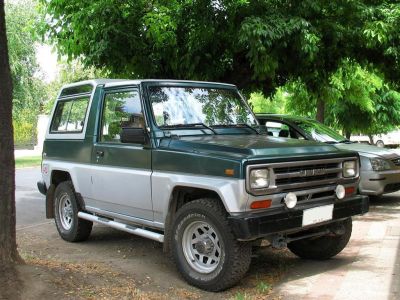 1983 SsangYong Korando I (K4) Dimensions, Size & Specs
1983 SsangYong Korando I (K4) Dimensions, Size & SpecsMeasurements of the 1983 SsangYong Korando I, engineered for optimal performance and comfort
| Dimensions | |
|---|---|
| Length: | 3860 mm152.0 in12.7 ft |
| Width: | 1700 mm66.9 in5.6 ft |
| Height: | 1850 mm72.8 in6.1 ft |
| Weight Specifications | |
| Curb Weight: | 1590 kg3505 lbs |
| Maximal permitted Weight: | 2050 kg4519 lbs |
| Tire Specifications | |
| Tire Size: |
|
The SsangYong Korando I (K4) is a classic compact off-road vehicle first introduced in 1982 and produced until 1996. Marking SsangYong's early footprint in the SUV market, the Korando I was designed with ruggedness and versatility for challenging terrains. It features a length of 3860 mm (approximately 152.0 inches), a width of 1700 mm (66.9 inches), and a height of 1850 mm (72.8 inches), putting it in the compact SUV category with a boxy and practical design suited for off-road driving. The vehicle's curb weight is 1590 kg (3507 lbs), while its maximum weight rating reaches 2050 kg (4519 lbs), reflecting its robust build and payload capacity. It rides on 215/75 R15 tires, which enhance its traction and stability on varied surfaces. The Korando I was popular for its utilitarian nature and reliable performance, equipped to handle off-road trails as well as urban roads. Its relatively small footprint compared to modern SUVs made it maneuverable yet spacious enough for passengers and cargo. This first-generation Korando reflects SsangYong's heritage in producing durable off-road vehicles with a balance of compact dimensions and practical weight. As a vintage SUV, it offers a glimpse into early 1980s Korean automotive engineering, blending rugged design with functional size specifications. Whether for enthusiasts interested in off-road vehicle history or those comparing compact SUVs from past decades, the Korando I remains a notable example in the category of small, sturdy off-roaders.
Discover the standout features that make the 1983 SsangYong Korando I a leader in its class
Have a question? Please check our knowledgebase first.
The SsangYong Korando I (K4) measures 3860 mm (151.97 inches) in length, 1700 mm (66.93 inches) in width, and stands 1850 mm (72.83 inches) tall. These compact dimensions make it a relatively small off-road vehicle suited for urban and rugged conditions. Its size reflects the typical SUV design of the early 1980s, balancing maneuverability with sufficient interior space for passengers.
With a width of 1700 mm (66.93 inches), the Korando I is fairly narrow compared to modern SUVs, which often exceed 1800 mm in width. This narrower track helps with navigating tight urban streets and easier parking in confined spaces. However, it may provide slightly less stability on rough off-road trails compared to wider vehicles. Overall, its width offers a good balance between agility and road presence.
The Korando I stands at 1850 mm (72.83 inches) tall, which gives it a commanding driving position and ample ground clearance. This height is advantageous for off-road scenarios, allowing the vehicle to clear obstacles like rocks and uneven terrain more easily than lower cars. However, its taller stature may increase wind resistance and affect aerodynamics, which was common for off-road vehicles of that era.
The 1983 Korando I has a curb weight of approximately 1590 kg (3507 lbs). This weight is moderate for an off-road vehicle and reflects the sturdy construction required for durability in rough conditions. The weight impacts fuel efficiency and acceleration, with heavier vehicles typically consuming more fuel, but it also contributes to vehicle stability and traction on challenging terrain.
The Korando I has a maximum weight rating of 2050 kg (4519 lbs). This includes the vehicle's curb weight plus passengers, cargo, and any additional equipment. The relatively high maximum weight capacity makes it practical for carrying several passengers and gear, ideal for off-road adventures, family trips, or light hauling tasks. Users should ensure not to exceed this limit to maintain safety and vehicle integrity.
The Korando I is equipped with 215/75 R15 tires. This tire size features a 215 mm width, 75% sidewall height relative to the width, and fits 15-inch wheels. These tires provide a good balance between on-road comfort and off-road traction, offering durability and cushioning over rough surfaces. The moderately tall sidewall aids in absorbing shocks from uneven terrain, which is essential for off-road performance.
With a length of 3860 mm (151.97 inches), width of 1700 mm (66.93 inches), and height of 1850 mm (72.83 inches), the Korando I should comfortably fit most standard residential garages. Typical garages have internal dimensions around 5.5 to 6 meters (18 to 20 feet) in length and about 2.4 to 3 meters (8 to 10 feet) in width and height. Therefore, parking the Korando I inside is feasible without much difficulty, provided the garage is a standard size and the driver maneuvers carefully.
The Korando I (K4), introduced in 1982, evolved from the original Jeep-based Korando models which SsangYong imported and assembled starting from the late 1970s. Compared to its predecessor, the Korando I offers a more refined and purpose-built design, though it maintains compact off-road dimensions typical of early SUVs. Its body dimensions remained relatively consistent with a focus on off-road capability, but with improvements in build quality and comfort. This generation marked a shift from merely licensed production to more indigenous engineering and styling.
When compared to other compact off-road vehicles of the 1980s, like the Suzuki Samurai, Jeep CJ series, or the early Toyota Land Cruiser variants, the Korando I holds its own in terms of size and utility. Its 3860 mm length and 1700 mm width position it as slightly more compact than many contemporaries, which often exceeded 4 meters in length. Its curb weight of 1590 kg is typical for vehicles with robust off-road construction. While not as powerful or spacious as full-size SUVs, the Korando I delivers capable off-road performance combined with a manageable size for urban use.
The SsangYong Korando I is classified primarily as an off-road vehicle or compact SUV. Produced between 1982 and 1996, it was designed to handle rugged terrains, making it suitable for outdoor activities, rural use, and light commercial applications. Its sturdy frame, reasonable ground clearance, and off-road tires made it popular among those needing a reliable vehicle for diverse conditions. While it also served as a family vehicle in some markets, its core strength lies in its off-road capabilities.
Discover similar sized cars.

| Production: | 1987-1998 |
|---|---|
| Model Year: | 1988 |
| Length: | 3840 mm151.2 in |
| Width: | 1690 mm66.5 in |
| Height: | 1850 mm72.8 in |
